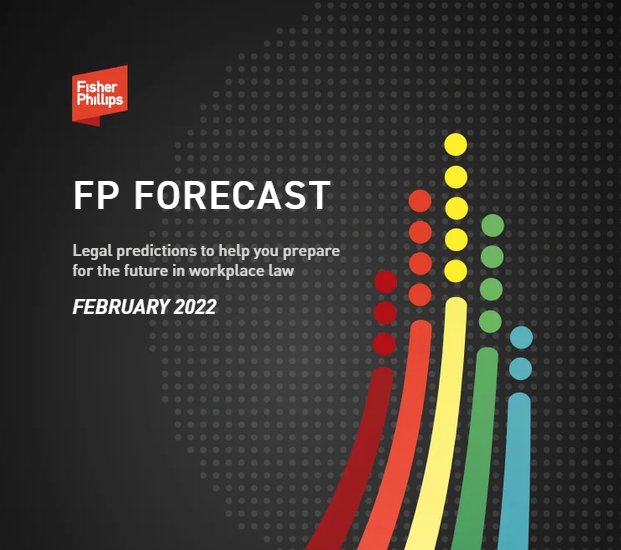FP Forecast: February 2022 Edition
Insights
2.15.22
Welcome to FP Forecast, a monthly outlook featuring Fisher Phillips thought leaders providing their insights into what employers can expect in 2022 and beyond. By following along each month, you’ll be in the best position to anticipate the expected changes and prepare your organization for what lies ahead. This month we look at the future of wage and hour law, corporate compliance and governance, and federal contractors – and take a special look at what manufacturing employers should prepare for.
Hagood Tighe, Kathleen Caminiti – Co-Chairs of FP’s Wage and Hour Practice Group
- Feds Will Turn Up the Heat – The Department of Labor announced in early February that it will be hiring at least 100 new wage and hour investigators, while we also understand it’s staffing up with agency lawyers for enforcement purposes – and there’s no doubt the agency will be looking for a return on that investment. The domino effect of these measures means we will see more investigations in 2022, increased liquidated damages and civil money penalties, more challenges filed by employers to DOL findings, and increased litigation. How can you avoid this mess? Begin auditing your pay practices now to ensure compliance before any outside investigation takes place.
- Business Arrangements Will Need be Reshuffled – A collection of federal agencies and state regulators have indicated that they will place independent contractor arrangements in their crosshairs in 2022, while also aiming to capture as many businesses as possible in joint employment situations. This effort to impose liability for misclassification and a variety of wage and hour violations should cause you to rethink business affiliations and structures with this new reality in mind.
- Hiring Minors to Address Workforce Shortages Will Come Back to Bite Unsuspecting Employers – Many employers that expanded their hiring pool by lowering minimum ages in 2021 will find themselves at the mercy of federal and state regulatory agencies and class action lawsuits in 2022. The wage and hour rules for hiring 14- and 15-year-olds are far more restrictive than those for 16- and 17-year olds, and those unfamiliar with the lay of the land will face the music. You must train your managers about these restrictions on and hold managers accountable for compliance.
- The Great Remote Work Migration Will Lead to The Great Remote Work Litigation – Working from home became entrenched in the lives of up to 60% of American workers for much of 2020 and 2021, and many employees will remain remote or hybrid for the foreseeable future. Which means you can expect a wave of wage and hour litigation from workers claiming they are not getting paid for all hours worked and have not been properly reimbursed for business expenses (Wi-Fi, data plans, cell phones, etc.). Two steps you can take: make the effort to track employees’ work through technology and consistent communication, and proactively develop policies and compliance systems.
Corporate Compliance and Governance
Ray Perez, Chair of FP’s Corporate Compliance and Governance Practice Group
- The Need to Report ESG Employment Data Will Increase – Both government regulators and private stakeholders will increase the pressure on organizations to ramp up their Environmental, Social and Governance (ESG) reporting. Both public and private employers will experience increasing demands to publicize their workforce diversity, pay equity audits, safety results and overall workforce data. You will need to develop strategies and systems to respond to these requests in an effective manner.
- Employers Will Face a Wave of Criminal Antitrust Indictments – The Department of Justice will look to make a splash in 2022 by announcing criminal indictments against employers – and you’ll see individual company officials named as defendants to capture attention. The two most common reasons for indictments will be no-poach agreements (pacts among employers not to recruit the other’s employees) and wage suppression agreements. You should spend the first quarter of the year carefully reviewing your hiring practices and the manner in which you share compensation information with industry groups and other employers to ensure compliance.
- Remote Whistleblowing Will Skyrocket – The increased use of remote and hybrid workplaces has led an increasing number of remote workers to feel less connected to their employer and coworkers – and this will result in a surge of whistleblower complaints over the next year. Besides taking steps to bolster your corporate culture and reengage your workers, you should publicize and encourage the use of internal reporting systems such as complaint procedures and ethics hotlines so that issues can be promptly investigated and corrected in-house.
- New Suppliers and Vendors Will Raise Employment Risks – As supply chains are stretched thin, employers will be pressured to use new suppliers in the U.S. and abroad to meet customer demands. These suppliers may not be properly vetted to confirm compliance with the company’s expectations for employment law and safety compliance. Potential compliance issues at these suppliers can create reputational and operational challenges for your company even if you have no direct responsibility for these issues. You will need to confirm you are appropriately evaluating the employment and safety practices at new suppliers to ensure adherence to the company’s expectations.
Affirmative Action and Federal Contract Compliance
Cheryl Behymer, Chair of FP’s Affirmative Action and Federal Contract Compliance Group, and Sheila Willis
- Infrastructure Work = Federal Contract Work – Many employers that have not previously chosen to enter into federal contracts or subcontracts will find themselves subject to the myriad requirements of affirmative action compliance for the first time thanks to opportunities borne of the infrastructure legislation. They will either voluntarily choose to do so for the obvious and immediate financial advantages or inadvertently acquire federal subcontractor status based on services or supplies they provide that are necessary for the performance of ultimate federal contracts. The first industries to benefit are likely the construction contractors awarded the projects, but manufacturing and logistics industries are necessary to support these ventures and will soon be implicated. You can expect to see a ripple effect the grows the federal subcontractor community exponentially.
- Affirmative Action Plan Vigilance Takes on Heightened Importance – Contractors have largely been accustomed to a relaxed approach to maintaining their affirmative action plans – but you’ll no longer have that luxury in 2022. OFCCP’s new federal contractor portal now creates a direct link between mandatory EEO-1 reports and your first-time requirement to annually certify with the government your compliance with affirmative action compliance requirements. Therefore, you must analyze and evaluate your current compliance efforts to ensure you meet all regulatory requirements, as you’ll need to certify accuracy under penalty of perjury and meet the June 30 deadline.
- EEO-1 Reports Will Be Innocuous No More – The new OFCCP Director Jenny Yang had been the EEOC’s strongest proponent of the currently defunct EEO-1 Component 2 requirement that forced employers to turn over pay data and hours worked reports, and all indications are she will once again lead the charge to make such data available to the public in 2022. Consistent with OFCCP’s early but vigorous insistence on pay transparency, a new EEO-1 Component 2 report may be added to the posting requirements for the OFCCP Portal for the federal contractor community in the coming months. This means the previously innocuous EEO-1 reports may assume a more prominent role as reflections of your company’s compensation structure and philosophy.
- Feds Will Scrutinize Contractors’ Hiring Practices that Utilize AI – As federal contractors struggle to attract qualified applicants in the current marketplace, many are getting creative in their efforts to woo the best and brightest – but federal regulators may train a close eye on you if you give your computers too much power. The increased use of artificial intelligence (AI) as a recruiting tool has led the EEOC and the OFCCP to caution employers to be careful about over-reliance on algorithms in making employment decisions for fear of unintentional discriminatory outcomes. If you rely on AI at all, you will likely need to include some strong indemnification language in any vendor agreements to provide some measure of protection.
Steve Mitchell and Dave Kresser, Co-Chairs of FP’s Manufacturing Industry Team
- Astute Workforce Communication Will Prove Essential – In 2022, manufacturers will continue to feel pressure to meet consumer demand with the challenges of an undependable supply chain and an unstable workforce. But the trend of increasing wages and providing large bonuses to get employees to come to work will prove unsustainable. Any efforts to scale back wages – even to simply lower the increases to a historically acceptable level – will be met with resistance by employees accustomed to the huge increases over the last two years and anxious over growing inflation levels. You must be prepared to astutely communicate your reasoning with employees, some of whom will vocalize their disagreement with these changes – both of you knowing that organized labor is waiting in the wings to try to take advantage of any turmoil. Don’t wait until you have bad news to report. To communicate with employees in the coming year, continue to invest in and regularly utilize non-traditional forms of communication, such as social media and internal intranets and blog posts, not simply relying on group meetings that may not be feasible in our current environment.
- Employment Practices Will Need to be Reimagined Due to Automation – The coming year will see an acceleration of manufacturers expanding or implementing automation in their facilities – an increasingly popular tactic to address the workforce shortage and the movement to “onshore” more manufacturing capacity caused by supply chain issues. This will lead to inevitable challenges of training or replacing the workforce to fill the new jobs, which will certainly require different skills. You will need to prepare to implement a lawful and valid selection process when filling jobs, determine who and how to retrain, address layoffs for those who cannot fill the new roles, and confront any legal issues regarding allegations of discrimination or labor related issues when implementing the necessary changes.
- Environmental, Social and Governance (ESG) Will be Front and Center – As noted above in the Corporate Compliance and Governance section, stakeholders will expect to see measurable progress in ESG initiatives in 2022 – and manufacturing employers will face the most scrutiny. The three areas for you to focus your efforts in the next year:
- Sustainability and Greenhouse Gas Emissions. There will be expanded government oversight and stakeholder emphasis on greenhouse emission reductions and net neutral carbon policies in the coming year. Larger companies will exert more pressure on suppliers down the manufacturing supply chain to reduce CO2Large institutional investors and capital markets will be more and more reluctant to provide capital to manufacturers not focused on environmental and sustainability issues.
- Diversity, Equity, and Inclusion. Manufacturers will need to make DEI efforts more visible to employees, customers, investors, and the general public in 2022. These efforts are not only important to attract and retain valuable employees but will increase the pool of qualified applicants for hiring and promotion. In attempting to meet DEI goals, you must carefully navigate between promoting laudable goals and making employment decisions based on a quota system that risks claims from applicants and employees not selected based on their protected characteristics. The U.S. Supreme Court recently agreed to hear challenges to race-based selection criteria in the university setting, and we expect that these cases will raise awareness of these type of issues in the employment setting in the second half of 2022.
- ESG Reporting. Reporting ESG progress to regulators, investors, and the public will increase and be more heavily scrutinized in the coming year. While some skeptics claim that ESG reporting is used as a marketing tool rather than a reflection of a genuine commitment (“greenwashing”), expect increased demands for action and short-term ESG progress – longer term goal setting will no longer suffice. Standardization of ESG reporting will also ramp up in 2022, with key metrics and reporting frameworks becoming more refined and results vetted through non-profit advocacy organizations that rate ESG programs.
Conclusion
We will deliver monthly FP Forecast insights forecasting what to expect across the entire spectrum of workplace law over the entire course of 2022, so make sure that you are subscribed to Fisher Phillips’ Insights to get the most up-to-date information direct to your inbox. If you have further questions, contact your Fisher Phillips attorney or the authors of this Insight.
Related People
-
- Cheryl L. Behymer
- Senior Counsel
-
- Kathleen McLeod Caminiti
- Partner and Co-Chair, Wage and Hour Practice Group
-
- David R. Kresser
- Partner
-
- Stephen C. Mitchell
- Regional Managing Partner
-
- Raymond W. Perez
- Of Counsel
-
- J. Hagood Tighe
- Partner and Co-Chair, Wage and Hour Practice Group
-
- Sheila M. Abron
- Partner
Service Focus
- Affirmative Action and Federal Contract Compliance
- Corporate Compliance and Governance
- Wage and Hour







